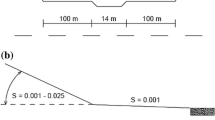Abstract
A flash flood caused by heavy storm in a short period of time is now one of the common natural disasters worldwide. The aim of this paper is to develop a new flood hazard index for use in local flood severity predictions in small ungauged catchments through the regression analysis between the flood hazard index and rainfall features. The flood events with the peak flow above a threshold discharge are targeted to estimate the flood hazard index among the annual maximum flood runoff hydrographs generated from a rainfall–runoff model for the long-term-observed rainfall data. To quantify characteristics of flood runoff hydrographs simulated for ungauged catchments, the new flood hazard index is measured by the average of the three normalized relative severity factors, such as the flood magnitude ratio, the rising curve gradient, and the rising average runoff to the peak time. The proposed flood hazard index shows a high correlation with logarithm of the short-duration rainfall for the two selected small ungauged catchments in the Korean Peninsula. The best-fit regression equation between the flood hazard index and rainfall patterns can be used in predicting the relative flash flood severity for small ungauged catchments.



Similar content being viewed by others
References
Bhaskar NR, French BM, Kyiamah GK (2000) Characterization of flash floods in Eastern Kentucky. J Hydrol Eng ASCE 5:327–331
Carpenter TM, Georgakakos KP (1993) GIS-based procedures in support of flash flood guidance. IIHR Report No. 366, Iowa Institute of Hydraulic Research, The University of Iowa: Iowa City, IA, USA
Carpenter TM, Sperfslage JA, Georgakakos KP, Sweeney TL, Fread DL (1999) National threshold runoff estimation utilizing GIS in support of operational flash flood warning systems. J Hydrol 224:21–44
Chungcheongnam Province Government (2004) The basic plan report for the Mae-gok river maintenance works. Chungcheongnam Province Government, Chungcheongnam
Clark CO (1945) Storage and the unit hydrograph. Trans ASCE 110:1419–1446
Doswell CAIII (1993) Flash flood-producing convective storms. In: Proceedings of the U.S.–Spain workshop on natural hazards, Barcelona, Spain, 8–11 June 1993, pp 97–107
Fread DL (1992) National weather service river mechanics: some recent development. In: Proceedings of the U.S./PRC flood forecasting symposium/workshop, Shanghai, China, 14–17 April 1992, pp 81–111
Kim ES, Choi HI (2011) Assessment of vulnerability to extreme flash floods in design storms. Int J Environ Res Public Health 8:2907–2922
Kim ES, Choi HI (2012) Estimation of the relative severity of floods in small ungauged catchments for preliminary observations on flash flood preparedness: a case study in Korea. Int J Environ Res Public Health 9:1507–1522
Kim BS, Kim HS (2008) Estimation of the flash flood severity using runoff hydrograph and flash flood index. J Korea Water Resour As 41:185–196
Korea National Emergency Management Agency (2011) The annual natural disaster bulletin. KNEMA, Seoul
Kyiamah GK (1996) Monitoring and characterization of flash floods. MS Thesis, Department of Civil Engineering, University of Louisville, Louisville, KY, USA
Lapenta KD, McNaught BJ, Capriola SJ, Giordano LA, Little CD, Hrebenach SD, Carter GM, Valverde MD, Frey DS (1995) The challenge of forecasting heavy rain and flooding throughout the Eastern Region of the National Weather Service. Part I: characteristics and events. Weather Forecast 10:78–90
Lin X (1999) Flash Floods in Arid and Semi-Arid Zones. International Hydrological Programme-V, Technical Documents in Hydrology, No. 23, UNESCO, Paris, France
Marchi L, Borga M, Preciso E, Gaume E (2010) Characterisation of selected extreme flash floods in Europe and implications for flood risk management. J Hydrol 394:118–133
Mogil HM, Monro JC, Groper HS (1978) NWS’s flash flood warning and disaster preparedness programs. Bull Am Meteorol Soc 59:690–699
Opitz HH, Summer SG, Wert DA, Snyder WR, Kane RJ, Brady RH, Stokols PM, Kuhl SC, Carter GM (1995) The challenge of forecasting heavy rain and flooding throughout the Eastern Region of the National Weather Service. Part II: forecast techniques and applications. Weather Forecast 10:91–104
River Forecast Center Development Management Team (2003) Flash flood guidance improvement team final report. National Weather Service, Springfield
Rodríguez-Iturbe I, Valdes JB (1979) The geomorphological structure of hydrologic response. Water Resour Res 15:1435–1444
Rogash JA, Racy J (2002) Some meteorological characteristics of significant tornado events occurring in proximity to flash flooding. Weather Forecast 17:155–159
Smith JA, Baeck ML, Zhang Y, Doswell CAIII (2001) Extreme rainfall and flooding from supercell thunderstorms. J Hydrometeorol 2:469–489
Smith JA, Baeck ML, Meierdiercks KL, Miller AJ, Krajewski WF (2007) Radar rainfall estimation for flash flood forecasting in small urban watersheds. Adv Water Resour 30:2087–2097
Sweeney TL (1992) Modernized areal flash flood guidance. NOAA Technical Report NWS HYDRO 44, National Weather Service, Springfield, VA, USA
US Army Corps of Engineers (USACE) (2000) Hydrograph modeling system. Technical Reference Manual. Hydrologic Engineering Center, Davis
US Natural Resources Conservation Service (1986) Urban hydrology for small watersheds. Technical Release 55 (TR-55), US Department of Agriculture, Washington, DC, USA
Vivoni ER, Entekhabi D, Bras RL, Ivanov VY, van Horne MP, Grassotti C, Hoffman RN (2006) Extending the predictability of hydrometeorological flood events using radar rainfall nowcasting. J Hydrometeorol 7:660–677
Williams GP (1978) Bankfull discharge of rivers. Water Resour Res 14:1141–1154
Wolman MG, Leopold LB (1957) River flood plains: some observations on their formation. Professional Paper 282-C, U.S. Geological Survey, Reston, VA, USA
Wonju City Government (2007) The basic plan report for the Oui-mi river maintenance works. Wonju City Government, Wonju
World Meteorological Organization (2007) Global approach to address flash floods. MeteoWorld, Geneva
Acknowledgments
This research was supported by the Yeungnam University research Grant (214A380091) in 2014.
Author information
Authors and Affiliations
Corresponding author
Rights and permissions
About this article
Cite this article
Kim, E.S., Choi, H.I. A method of flood severity assessment for predicting local flood hazards in small ungauged catchments. Nat Hazards 78, 2017–2033 (2015). https://doi.org/10.1007/s11069-015-1817-4
Received:
Accepted:
Published:
Issue Date:
DOI: https://doi.org/10.1007/s11069-015-1817-4




